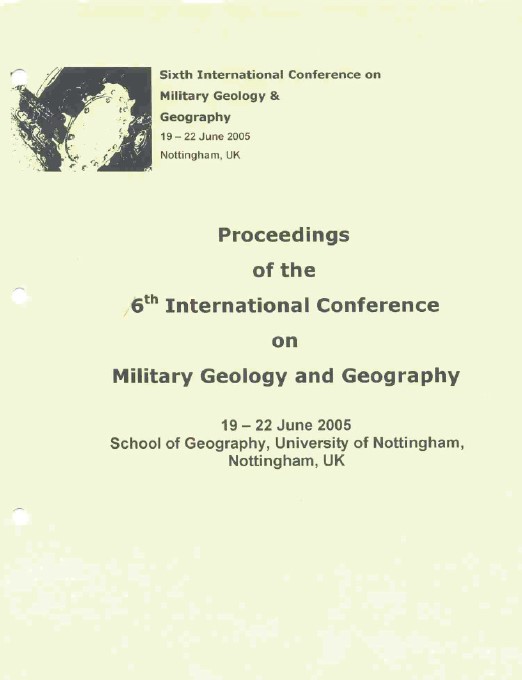Nottingham University, Nottingham, UK
(Conference summary reproduced with permission; original text published in: Häusler, H. 2009. Report on National and International Military Geo-Conferences held from 1994 to 2007, MILGEO, Nr. 30E, Austrian Ministry of Defence and Sports).
The time schedule of the three days Nottingham Conference lasted from Monday 20th June to Wednesday 22nd June. It offered daily keynotes, and two paralleling sessions, covering ten general topics (in the rooms A and B; Table 1).
Table 1 – Schedule
| Day | Session A | Session B | Excusion |
|---|---|---|---|
| Monday |
|
|
Newark Castle |
| Tuesday |
|
|
Battle of Bosworth and Fauld Crater |
| Wednesday |
|
|
Departure for 4 days study tour Normandy field trip D-Day (22 – 26 June) |
Thirty-five authors provided thirty-tree papers. Contributions from U.S. authors nearly equal those from UK and Canada. France and Estonia were represented by one contribution each (Table 2).

One of the highlights of the Nottingham Conference was the visit to the Battle of Bosworth Heritage Centre. The Battle of Bosworth (1485) is one of the three most decisive battles fought on English soil. In Britain it is conventional to regard Bosworth as marking the end of the Medieval era and the start of modern times – the Renaissance.
Despite its critical importance to the development of then English state little is known of the details of this battle. Henry Tudor won and Richard III lost the battle. Dr. R. Bradshaw and Dr. R. Abrahart led this excursion.
Dr. C. P. Nathanail led the excursion to the “Fauld Crater”. During World War II the Royal Air Force stored ordnance in deep mines within gypsum horizons of the Triassic Mercia Mudstone. On 24 November 1944 the largest explosion caused by conventional weapons in either world war took place when some 3500 tons of high explosives accidentally blew up. A crater 100 metres deep and 250 metres in diameter was created. Several memorials commemorate the seventy people who lost their lives. The crater is an impressive feature in the North Staffordshire countryside. Seismographs are reputed to have recorded the shock waves at Casablanca.
The four days post conference excursion to D-Day Beach Landings, Normandy, France was led by Dr. E.P.F. Rose and Dr. C.P. Nathanail. Operation Overlord, the Allied liberation of North West Europe, began on 6 June 1944 and marked one of the most significant contributions to military operations made by geologists. This study tour retraced the footsteps of British, Canadian, U.S. and other allied troops and examined the influence, which geology and terrain had on Operation Neptune.
The proceedings of the Nottingham Conference 2005 were published by Land Quality Press.
Table 2 – Papers
| Author | Title | Subject |
|---|---|---|
| ABRAHART & BRADSHAW | Terrain and tactics at the Battle of Waterloo, 18 June 1815 | Geology, geomorphology |
| BRADSHAW & ABRAHART | Newark Civil War defences | Geography |
| BRADSHAW & ABRAHART | The Battle of Bosworth 1485: contested locations for the battlefield site | Geography |
| DOYLE | “Six VC´s before breakfast”: terrain and the Gallipoli Landings, 25 April 1915 | Geography, terrain intelligence, WWI |
| EHLEN | Magnificent men in flying machines: Tactical control of the High Ground, Korea, 1950 | Geography |
| EHLEN & WHISONANT | Casualties (Opfer), geology, and terrain in the American Civil War | Geology, DEM |
| FERLAND | Military cartography trends for situation awareness | Cartography |
| FRANKLIN & GUTH | The effects of DEM re-interpretation on viewshed computations | Topography, DEM |
| FRIEND | Environmental analysis in support of the military commander | Goings, Military geology |
| GALGANO | “Sichelschnitt”: May 1940, the German attack through the Ardennes – A geographic analysis of a decisive campaign | Geography, WWII |
| GUTH | Challenges for military application of high resolution DEMs | Topography, DEM |
| HAMILTON | Imagery of the battlescape, Roger Fenton and the Crimean War | History |
| HARRISON & THOMPSON | Terrain and non-linearity: Kampfgruppe Peiper and the Battle of the Bulge, December 1944 | Geology (terrain, climate; movement), WWII |
| HENDERSON | The geology of the 1776 Battle of Brooklyn and battlefield preservation in an urban environment | Geology, history |
| HEFFERNAN | Geography, military intelligence and WWI | Geography, intelligence, WWI |
| JACKSON | The changing nature of geo-intelligence and consequential research challenges | Intelligence, US NGA |
| McDONALD & CALDWELL |
Geochemical characteristics of Iraqi dust and soil samples and related impacts to weapon malfunctions | Geology |
| MAHANEY & TRICART | Hannibal´s debacle in the Combe de Queyras in 218 B.C.: The unknown Gallic commander | Geography, history |
| MAHANEY, KALM & DIRSZOWSKY |
The Hannibalic invasion of Italia in 218 B.C.: geological/topographical analysis of the invasion routes | Geography, history |
| MARTIN | Non-control of space and other spatial aspects of peacekeeping operations | Geography, peacekeeping, in general |
| MEHARG | Identicide and the geographies of post-conflict reconstruction | Post-conflict reconstruction |
| NATHANAIL | The tectonic impact of the Manhattan Project | Geology |
| NATHANAIL | The Fauld Crater: WWII’s largest conventional explosion | Geology, WWII |
| OBROCK & GUTH | Filling holes in SRTM DEMs using ASTER DEMs | Topography |
| PALKA & HARMON | A geographical analysis of Australia for tropical testing of U.S. Army materiel and systems | Geography |
| PASSMORE & HARRISON |
The geography of battle in the Ardennes campaigns of 1940 and 1944 | Geography, WWII |
| ROSE | Military applications of geology: a historical perspective | Geology |
| ROSE | German military geologists and fortification of the British Channel Islands during World War II | Geology, WWII |
| ROSE | British military geological terrain evaluation for “Operation Overlord”: the Allied Invasion of Normandy in June 1944 | Geology, WWII |
| SWANSON | Multi-resolution digital elevation model visualization and analysis | Topography, DEM, remote sensing, DEM |
| SCHROEDER | Commonwealth and American tactics in World War II | Geography, tactics, WWII |
| WALTHAM & HARMON | Military uses of the sandstone caves of Nottingham, UK | Geology |
| WHISONANT, UNDERWOOD & SURBER | Shock and awe on the union right: Geologic and geomorphological analysis of the battle of Chancellorsville | Geology |
